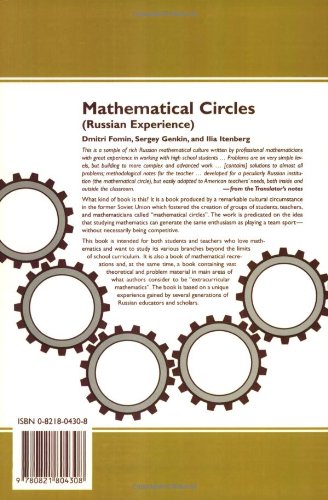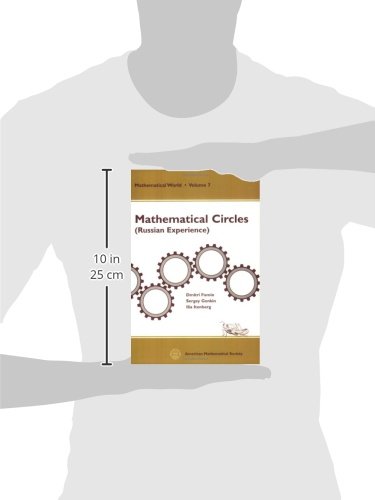معلومات عنا
دعم العملاء
احصل على التطبيق

قم بتوجيه الكاميرا لتنزيل التطبيق
حقوق الطبع والنشر © 2024 Desertcart Holdings Limited




Full description not available
A**U
Outstanding Book on Problem Solving
This is probably the best single volume for a student learning to solve problems at a reasonably advanced level. The introduction is gentle, and the authors talk directly to the readers throughout the book. There is an enormous amount of examples and exercises, each with an elegant idea behind it. It covers a lot of topics not treated in the standard curriculum, but yet it is not isolated from the school work. I recommend this strongly.
C**C
Sub-par... Refer to A Moscow Math Circle: Week-by-Week Problem Sets
While covering much of the same ground as A Moscow Math Circle: Week-by-Week Problem Sets, this book pales in comparison, both due to poorer organization and more work to implement by a prospective math circle instructor. The material jumps around a lot (great if you have a mixed group of students, poor if you have a homogeneous group of students). The highlight of this book is the SMALL discussion of the culture and education of mathematics students in Russia, but even that is not as good as the aforementioned title. Overall, its a fine collection of problems at the secondary level for U.S. students, but better alternatives (using U.S. materials like Contest Problem Books I-IX that feature AMC problems) exist.
R**U
very useful book for my son
because its a wonderful book in mathematics recommended to us by a bright spirit; it would be very useful for my son, a talented young boy, a witty mind, as it is written in affordable language and with a good dose of humor; also I don't try to mask my astonishment regarding the Russian inteligence
D**A
Excellent
The product is excellent. It is quite explanatory. The exercises have various levels of difficulty. Ideal for those who want to delve in mathematical olympiad problems.
K**I
A great source of thought-provoking questions.
This is a tremendous source of challenging questions - I randomly pick out questions to test my students.
P**.
A superb collection of problems and mathematical insights.
Russia perennially places among the top three performers in the International Mathematical Olympiad, the world's most prestigious mathematical competition for high-school students. The "mathematical circle" is undoubtedly one element of the mathematical culture that has contributed to Russia's success in that competition.A Russian mathematical circle is not a geometrical shape, but rather a group of mathematically motivated students guided by a university-level mathematician who helps the students enlighten themselves about simple, yet beautiful and powerful, mathematical concepts. Fomin's Mathematical Circles is a strikingly elegant, practical tool for enabling American high-school teachers and math coaches to replicate the Russian mathematical circle here.Mathematical Circles has two parts, each intended to be taught over one year. The first part has sections covering parity, combinatorics, divisibility and remainders, the pigeon-hole principle, graphs, the triangle inequality, and games. The second part has sections covering more advanced topics in divisibility, combinatorics, and graphs, as well as sections on invariants, number bases, geometry, and inequalities.Each section begins with a short introduction addressed to the teacher and then proceeds to a series of problems periodically interspersed with concise explanations about new concepts being introduced through the problems and pedagogical advice related to those concepts. In any given section, the first problem is generally extraordinarily simple. The first problem in the parity section is:Problem 1. Eleven gears are placed on a plane, arranged in a chain as shown [in a diagram with eleven gears interlocking in a circular arrangement]. Can all the gears rotate simultaneously?What a beautiful first problem this is for illustrating the utility of the parity concept as a mathematical tool! The parity-based argument not only leads rapidly to a solution, but also disposes of the whole class of problems of this sort, regardless of the number of gears.In the inequality section, Fomin introduces the triangle inequality, the most important inequality in elementary geometry. When this inequality is proved in conventional American geometry textbooks, the proof generally involves the construction of an altitude and comprises multiple lines of statements and reasons. Fomin's proof is algebraic and comprises all of one line.Mathematical Circles overflows with such poetry. The problems are well conceived, well composed, well sequenced, and outright interesting. For those teachers interested in deepening their own understanding of mathematics, in search of material to enhance the traditional curriculum, or coaching math clubs or teams, Mathematical Circles is an invaluable tool. I recommend it without reservation.
S**G
A great book for young students.
I bought this book to help me learn how to solve problems. However, when it arrived, I realised it was destined as a book for 12 to 14 year old students. Still, I gave it a try ( I am 19 years old). The problems are well stated, easy to do, and methodologicaly sound. I found the problems too easy, but my little brother ( 9 years old ) had trouble. It's great for some young students who would like to learn the basics of problem solving.
ترست بايلوت
منذ شهرين
منذ شهر